Myths are an inescapable reality of growing up in India. However, while a cursory awareness of myths is an inevitable part of the Indian identity, expertise on what these myths represent and how they can be applied in daily life is the domain of a select few. Straddling this rarefied space of knowledge on all things myths is Devdutt Pattanaik, who has done more than anybody else in current times to make myths compelling and convenient for the common Indian. Over the last few years, Pattanaik has also emerged as one of the most strident critics of Western ideas and their imposition on Indian thinking and lifestyle.
My Kolkata caught up with Pattanaik at the recently concluded Kolkata Literature Festival (KLF) on the grounds of the 45th International Kolkata Book Fair to pick his brains on the meaning of myths, how Western standards have distorted Indian ideas, Hinduism versus Hindutva and more.
Edited excerpts from the conversation follow.
A myth gives our lives meaning
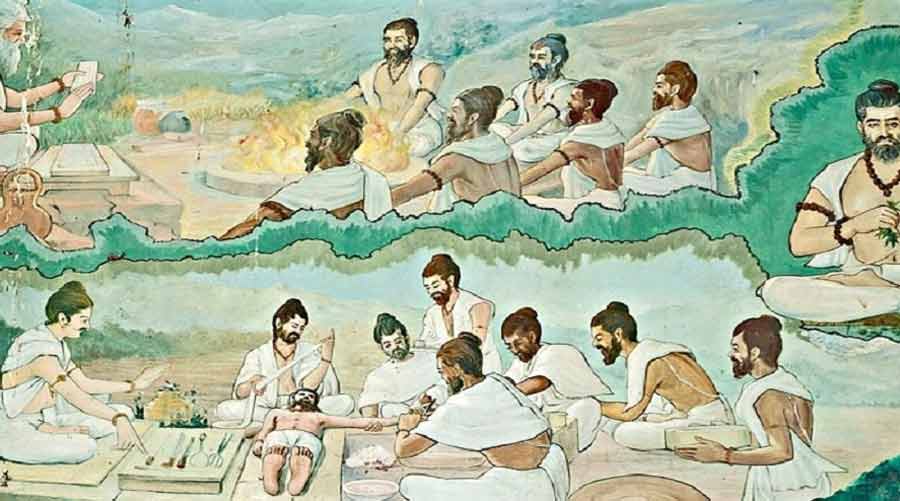
A myth is necessarily subjective and is handed down from one generation to the next TT Archives
My Kolkata: Let us start by getting definitions in place. When we talk about myths, there are so many definitions flying around. Tell us what exactly is meant by a myth.
Devdutt Pattanaik: A myth is how a culture imagines the world and life, it’s a subjective truth of a people. It belongs to a people, it doesn’t belong to the world. It will always say how everything began and how everything is going to end, so a myth gives our lives meaning. That’s what a myth is about, nothing else.
The assumption in the West is that human beings are rational
How did you first get drawn to studying myths in exhaustive detail and what have been some of the key insights you have gained about the process of studying myths?
I enjoyed myths like any child reading Amar Chitra Katha. But I realised that our understanding of the subject is usually through Western scholars and that nobody really writes seriously on mythology in India. Even today, we don’t. Technically speaking, you can’t even write a myth, it’s something that has to be transmitted over generations. What we’ve got today are mythological fiction writers, which is a very old tradition in India. But mythology is an analytical subject, just like anthropology or sociology, and it’s not taught technically in India. All this led me to think that somebody should do it. So I took up the mantle and I’ve been doing it ever since in my own way.
In doing so, I’ve seen the limitations of the West. The assumption in the West is that human beings are rational, but that assumption isn’t there in India. We, as a culture, don’t believe that people are rational, which is why we should also see the scholarship of mythology very differently.
We usually prefer the inherited subjective truths… our parents, families, tribes and clans tell us
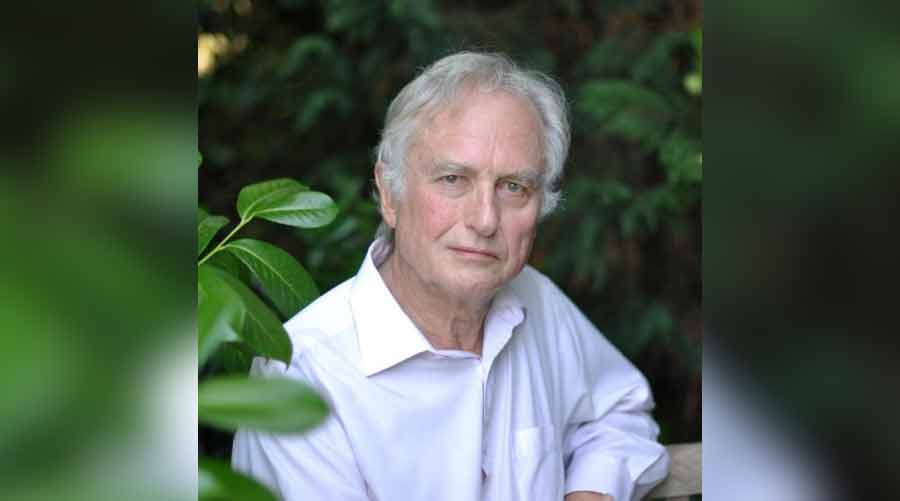
Pattanaik firmly rejects the rationalist discourse championed by Western thinkers like Richard Dawkins @Richard Dawkins/Twitter
Do myths need an element of either scientific truth or historical accuracy or are they concerned with a different kind of truth altogether?
The idea that myths require scientific truth or historical accuracy, something that the likes of Richard Dawkins propound as part of their rationalist discourse, is a very 19th century, very colonial way of thinking. The West believes that there’s only one truth, their brains can’t accommodate more than one truth. First, they said that the one truth is the church, then they said it’s science. But human brains are actually capable of accommodating multiple truths. For instance, the Jains have a concept called Anekantavada, which means different ways of seeing the world. We need these concepts because science can’t answer all our questions, such as whether there’s life after death. No scientist can answer that question, which means it remains in the subjective realm. We usually prefer the inherited subjective truths, things that our parents, families, tribes and clans tell us.
So, if you wipe out mythologies, you’ll wipe out tribes, too. A rationalist is essentially enabling the colonial discourse of tribal cultural genocide because none of the tribal myths are rational, they’re based on imagination. While it’s easy to focus on, even attack, the mythologies of the established religions, we shouldn’t forget that mythology isn’t just of the elite, it’s also of the tribal communities. Their very identity comes from myths and an obsession over historical accuracy or scientific truth or rationality can destroy their identity.
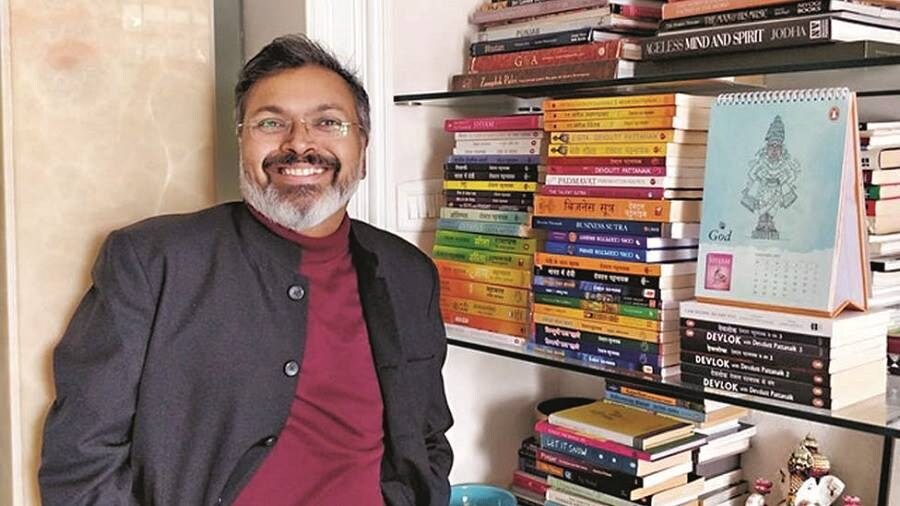
With more than 40 titles to his name till date, Devdutt Pattanaik is one of the most prolific writers on mythology in the world TT Archives
You have been using the word “West”, but do you not think even the labels of the West and the East are problematic? For the West, India and China are part of the East and come under one banner; what is your take on these territorial labels?
These are simple shorthands to explain concepts. Any serious thinker knows it’s not that simple. Moreover, when we use the word “West”, it means Western Europe. I don’t think the West thinks Russia is the West. Or that Ukraine is the West. So they mean Western Europe and even America as the West. From the Indian perspective, the West is the land of monotheism, so it’s Europe and America along with the Middle East and the near East. The Indian notion of West and East is different from the European notion of West and East.
We somehow, even today, believe that the white man was right

Pattanaik cites the Jagannath temple in Puri as a great example of how the hermit and the courtesan used to coexist in India TT Archives
When we look at Indian myths, there’s such a free exploration of the themes of sexuality, including that of queerness. But when we look at Indian society, it becomes a hush-hush issue. Why do you think that is the case?
This is another colonial hangover we’re carrying that we’ve not been able to let go. In traditional Indian society, you had the hermit and the courtesan living next to each other. If you went to the Jagannath temple in Puri back then, there would be the matthas where the yogi would live but there would also be the devadasi who’d be singing and dancing. Who has been wiped out? The devadasi. Why has she been wiped out? Because devadasis were considered to be sex workers or exploited women. But the yogis are still around. So is it a masculine discourse? Is it a colonial discourse? The fact is that our understanding of sexuality in India was seen as dirty by the standards of the so-called European Enlightenment discourse. The West couldn’t understand our country where people wore fine, revealing fabrics and were often semi-naked. Here we never thought much about it because it’s a hot country. But the Europeans were horrified, they wore tight pants even in hot weather. If you see the images of whites in Kolkata in the 18th century, they are dressed in these funny clothes. It’s a very powerful visual statement from the white Europeans that they won’t adapt. And that’s what happened to our culture and the way we see sexuality. We somehow, even today, believe that the white man was right.
What makes a good head of the family – someone who shares or someone who captures?
Let us shift our focus to two of the most widely read Indian myths, the Ramayana and the Mahabharata. How are they similar and why should today’s youngsters read them?
I’ve written a book called Ramayana versus Mahabharata: My Playful Comparison, which argues that both essentially have the same structure. Both are about kinship, property disputes and the question of who should be king. They’re relevant because they talk about what makes a good king, and even more importantly in today’s context, what makes a good head of the family — is it someone who shares or is it someone who captures?

The Ramayana and the Mahabharata are structurally and thematically similar, according to Pattanaik
Both the Ramayana and the Mahabharata have complex and layered antagonists such as Ravan and Duryodhan, who have become prototypes of villains in popular culture. But is the idea of evil or a villain something that is inherent to Indian myths or is that also a Western import?
All stories need a hero and a villain. It’s like cooking, where you need both sweet and sour flavours to help enhance each other. The real question is which are the characters that are considered good and bad. In Western stories, it’s the characters who follow some sort of transcendental law. But in India, it’s someone who includes. Again, the Chinese have a very different concept, of someone who keeps the order versus someone who disrupts the order, which goes against the binary of good versus bad. In the Abrahamic texts, it’s the clash between followers of the law or the word of God versus those who disobey. So, there’s no one concept of hero or villain, good or bad. This proves that Joseph Campbell’s idea of the monomyth doesn’t hold true, because it reduces being a hero to just one spice in a world of thousand spices.
For me, LSD stands for Lakshmi, Saraswati and Durga
We have been speaking so much about the West and its assumptions and obsessions. One such obsession or craze is LSD. But you have coined your own Indian version of LSD. Tell us about that and how every component of your LSD is dependent on each other.
Haha yes, for me, LSD stands for Lakshmi, Saraswati and Durga. To sum up their relationship and interdependence, I can say that Lakshmi stands for the resources you need, Durga stands for the power you need and Saraswati stands for the knowledge you need. In life, in order to be happy, you need wealth, power and knowledge. You need all three of them in the right dose or else you’re going to be unhappy. That’s how their interdependence is born. Because without any one, the other two alone can’t bring happiness.
India needs to focus on Lakshmi and everything else will follow
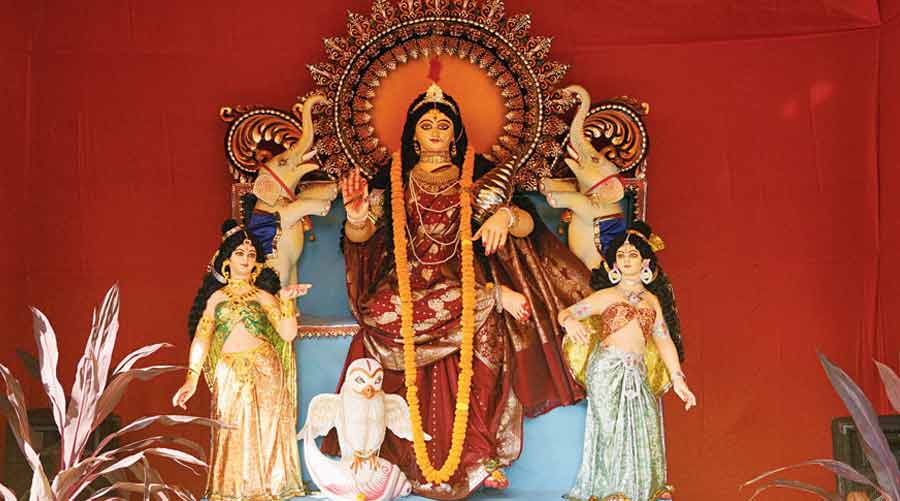
The wealth symbolised by Lakshmi is India’s most important requirement today, feels Pattanaik TT Archives
Of all the Hindu gods and goddesses you have studied and researched on, which one has fascinated you the most? Which one do you want to keep talking about in multiple ways?
Well, if I look at what India needs today, it has to be Lakshmi. India needs to focus on Lakshmi. We have a lot of things, but we’re still such a poor country. We keep harking back to the glory days of India, but what do these glory days mean? They mean those times when we had a lot of money, when markets and manufacturing was largely indigenous. I think we need to focus more on Lakshmi and everything else will follow.
One of the greatest epics written in the 17th century was the Bengali…. ‘Nabivamsa’
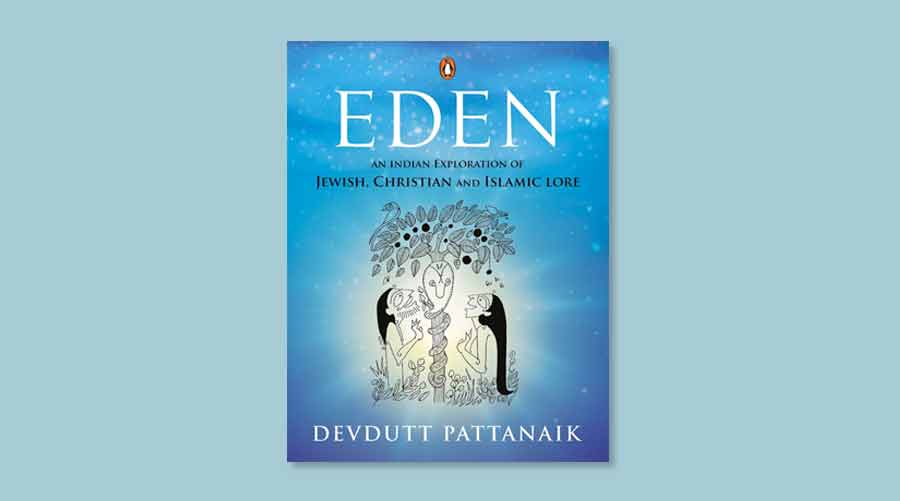
In Eden, Pattanaik contextualises Abrahamic stories within a distinctively Indian mindscape
In your recent book Eden: An Indian Exploration of Jewish, Christian and Islamic Lore, you spoke about the Indian perspective of Abrahamic myths. What, according to you, are the major differences and similarities between these Abrahamic myths and the Indian ones?
The best part is the differences and not so much the similarities. What you find in Abrahamic myths is the belief in one god and the laws of that god. This idea doesn’t exist in India, where there are many truths, many gods, many ways of looking at everything. Tell me something, have you heard of Nabivamsa?
No, we haven’t. What is it?
So, a lot of the Abrahamic tales were translated in India into the local languages. One of the greatest epics written in the 17th century was the Bengali retelling of the life of the prophets by Saiyad Sultan, who wrote this beautiful epic called Nabivamsa. The stories in it are more relatable to the Sunderbans than to the deserts of Arabia. But there’s practically no awareness about it, be it among the scholars or the lay person. You know why? Because we’ve been told that Islamic myths have to be in Arabic and Persian. But there’s a whole culture of Islamic myths in Bengali as well as in Tamil, Malayalam and other regional languages. While there are obvious differences between Abrahamic myths and the traditional Indian ones, it’s also possible to Indianise these Abrahamic myths and integrate them into our larger diverse culture.
Hindutva is a political discourse, a political movement that’s trying to become powerful

The terms Hinduism and Hindutva were both invented in the 19th century, reminds Pattanaik Courtesy: Devdutt Pattanaik
Lastly, on the issue of diversity and integration, what do you make of the ongoing attempts to homogenise a diverse philosophy like Hinduism through the lens of Hindutva? Additionally, if you could tell us how Hinduism and Hindutva differ?
There’s certainly a monolithic structure that’s being imposed on Hinduism right now with no understanding of how Hinduism is different in different places. Hinduism in Bengal is different from what it is in Odisha or Maharashtra, for instance. What we’re witnessing is the mainstreaming of Hindi-belt Hinduism, which even parts of the Hindi-belt don’t agree with.
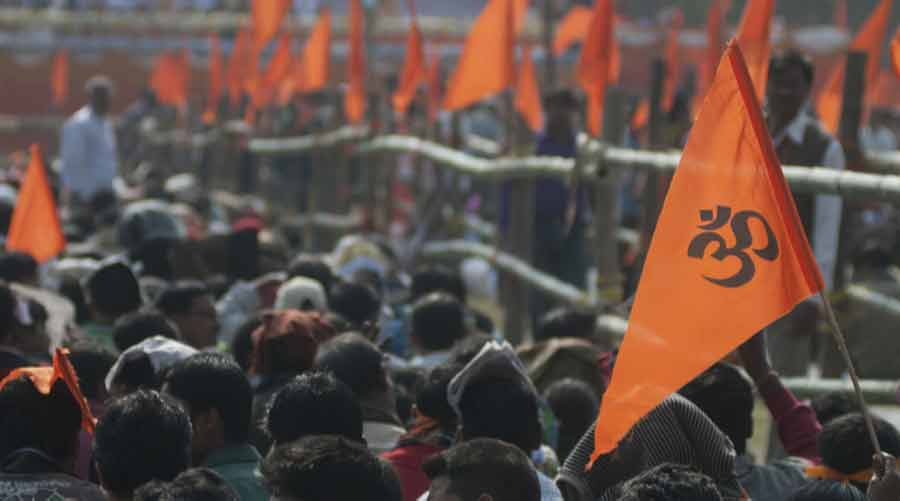
Pattanaik argues that Hindutva is a purely political movement, divorced from the essence of Hinduism TT Archives
As for Hindutva, it’s a word that was invented in 1894 by a Bengali gentleman called Chandranath Basu. Before the 1890s, Hindutva didn’t exist, just as Hinduism didn’t exist semantically before it was created, again in Bengal, by Raja Rammohan Roy in 1816. Before that, you had the word Hindu Dharma as opposed to Turuka Dharma, which was used to differentiate between Indians and the Turks who came to India.
To me, Hindutva is a political discourse, a political movement that’s trying to become powerful. It has nothing to do with the Vedas, the Puranas, the Upanishads or the Shastras. Those who advocate it are on their own journey to say whatever they want to get votes, which is good for them. Politicians have to do what they can in order to get votes. But if you have to understand Hinduism, you can’t do it through Hindutva.
For that, you’ve got to read the books of Devdutt Pattanaik!